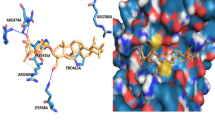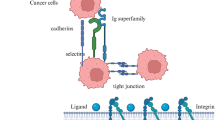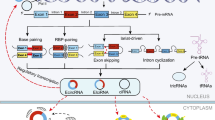Abstract
Sorcin, a 22-kDa calcium-binding protein, renders cancer cells resistant to chemotherapeutic agents, thus playing an important role in multidrug resistance. As there is a clear association between drug resistance and an aggressive phenotype, we asked whether sorcin affects also the motility, invasion, and stem cell characteristics of cancer cells. We have used both RNA interference (transient and stable expression of hairpins) and a lentiviral expression vector to experimentally modulate sorcin expression in a variety of cells. We demonstrate that sorcin depletion in MDA-MB-231 breast cancer cells reduces the pool of CD44+/CD24− and ALDH1high cancer stem cells (CSCs) as well as mammosphere-forming capacity. We also observe that sorcin regulates epithelial-mesenchymal transition and CSCs partly through E-cadherin and vascular endothelial growth factor expression. This leads to the acquisition of an epithelial-like phenotype, attenuating epithelial-mesenchymal transition and suppression of metastases in nude mice. The sorcin-depleted phenotype can also be reproduced in lung adenocarcinoma A549 cells and lung fibrosarcoma HT1080 cells. In addition, overexpression of sorcin in MCF7 cells, which have low endogenous sorcin expression levels, increases their migration and invasion in vitro. This offers the rationale for the development of therapeutic strategies down-regulating sorcin expression for the treatment of cancer.





Similar content being viewed by others
References
Al-Hajj M, Wicha MS, Benito-Hernandez A, Morrison SJ, Clarke MF (2003) Prospective identification of tumorigenic breast cancer cells. Proc Natl Acad Sci USA 100(7):3983–3988. doi:10.1073/pnas.05302911000530291100
Mani SA, Guo W, Liao MJ, Eaton EN, Ayyanan A, Zhou AY, Brooks M, Reinhard F, Zhang CC, Shipitsin M, Campbell LL, Polyak K, Brisken C, Yang J, Weinberg RA (2008) The epithelial-mesenchymal transition generates cells with properties of stem cells. Cell 133(4):704–715. doi:10.1016/j.cell.2008.03.027
Hermann PC, Huber SL, Herrler T, Aicher A, Ellwart JW, Guba M, Bruns CJ, Heeschen C (2007) Distinct populations of cancer stem cells determine tumor growth and metastatic activity in human pancreatic cancer. Cell Stem Cell 1(3):313–323. doi:10.1016/j.stem.2007.06.002
Giannoni E, Bianchini F, Masieri L, Serni S, Torre E, Calorini L, Chiarugi P (2010) Reciprocal activation of prostate cancer cells and cancer-associated fibroblasts stimulates epithelial-mesenchymal transition and cancer stemness. Cancer Res 70(17):6945–6956. doi:10.1158/0008-5472.CAN-10-0785
Dean M, Fojo T, Bates S (2005) Tumour stem cells and drug resistance. Nat Rev Cancer 5(4):275–284. doi:10.1038/nrc1590
Zhang W, Feng M, Zheng G, Chen Y, Wang X, Pen B, Yin J, Yu Y, He Z (2012) Chemoresistance to 5-fluorouracil induces epithelial-mesenchymal transition via up-regulation of Snail in MCF7 human breast cancer cells. Biochem Biophys Res Commun 417(2):679–685. doi:10.1016/j.bbrc.2011.11.142
Saxena M, Stephens MA, Pathak H, Rangarajan A (2011) Transcription factors that mediate epithelial-mesenchymal transition lead to multidrug resistance by upregulating ABC transporters. Cell Death Dis 2:e179. doi:10.1038/cddis.2011.61
Haslehurst AM, Koti M, Dharsee M, Nuin P, Evans K, Geraci J, Childs T, Chen J, Li J, Weberpals J, Davey S, Squire J, Park PC, Feilotter H (2012) EMT transcription factors snail and slug directly contribute to cisplatin resistance in ovarian cancer. BMC Cancer 12:91. doi:10.1186/1471-2407-12-91
Zhu K, Chen L, Han X, Wang J, Wang J (2012) Short hairpin RNA targeting Twist1 suppresses cell proliferation and improves chemosensitivity to cisplatin in HeLa human cervical cancer cells. Oncol Rep 27(4):1027–1034
Meyers MB, Pickel VM, Sheu SS, Sharma VK, Scotto KW, Fishman GI (1995) Association of sorcin with the cardiac ryanodine receptor. J Biol Chem 270(44):26411–26418
Deng L, Su T, Leng A, Zhang X, Xu M, Yan L, Gu H, Zhang G (2010) Upregulation of soluble resistance-related calcium-binding protein (sorcin) in gastric cancer. Med Oncol 27(4):1102–1108. doi:10.1007/s12032-009-9342-5
Yokota T, Kouno J, Adachi K, Takahashi H, Teramoto A, Matsumoto K, Sugisaki Y, Onda M, Tsunoda T (2006) Identification of histological markers for malignant glioma by genome-wide expression analysis: dynein, alpha-PIX and sorcin. Acta Neuropathol 111(1):29–38. doi:10.1007/s00401-005-1085-6
Diaz-Blanco E, Bruns I, Neumann F, Fischer JC, Graef T, Rosskopf M, Brors B, Pechtel S, Bork S, Koch A, Baer A, Rohr UP, Kobbe G, von Haeseler A, Gattermann N, Haas R, Kronenwett R (2007) Molecular signature of CD34(+) hematopoietic stem and progenitor cells of patients with CML in chronic phase. Leukemia 21(3):494–504 10.1038/sj.leu.2404549
Tan Y, Li G, Zhao C, Wang J, Zhao H, Xue Y, Han M, Yang C (2003) Expression of sorcin predicts poor outcome in acute myeloid leukemia. Leuk Res 27(2):125–131
Landriscina M, Laudiero G, Maddalena F, Amoroso MR, Piscazzi A, Cozzolino F, Monti M, Garbi C, Fersini A, Pucci P, Esposito F (2010) Mitochondrial chaperone Trap1 and the calcium binding protein Sorcin interact and protect cells against apoptosis induced by antiblastic agents. Cancer Res 70(16):6577–6586. doi:10.1158/0008-5472.CAN-10-1256
Parekh HK, Deng HB, Choudhary K, Houser SR, Simpkins H (2002) Overexpression of sorcin, a calcium-binding protein, induces a low level of paclitaxel resistance in human ovarian and breast cancer cells. Biochem Pharmacol 63(6):1149–1158
Qu Y, Yang Y, Liu B, Xiao W (2010) Comparative proteomic profiling identified sorcin being associated with gemcitabine resistance in non-small cell lung cancer. Med Oncol 27(4):1303–1308. doi:10.1007/s12032-009-9379-5
Zhou Y, Xu Y, Tan Y, Qi J, Xiao Y, Yang C, Zhu Z, Xiong D (2006) Sorcin, an important gene associated with multidrug-resistance in human leukemia cells. Leuk Res 30(4):469–476. doi:10.1016/j.leukres.2005.08.024
Yague E, Armesilla AL, Harrison G, Elliott J, Sardini A, Higgins CF, Raguz S (2003) P-glycoprotein (MDR1) expression in leukemic cells is regulated at two distinct steps, mRNA stabilization and translational initiation. J Biol Chem 278(12):10344–10352. doi:10.1074/jbc.M211093200
Su Y, Cheng X, Tan Y, Hu Y, Zhou Y, Liu J, Xu Y, Xie Y, Wang C, Gao Y, Wang J, Cheng T, Yang C, Xiong D, Miao H (2012) Synthesis of a dual functional anti-MDR tumor agent PH II-7 with elucidations of anti-tumor effects and mechanisms. PLoS One 7(3):e32782
Lombardo Y, Filipovic A, Molyneux G, Periyasamy M, Giamas G, Hu Y, Trivedi PS, Wang J, Yague E, Michel L, Coombes RC (2012) Nicastrin regulates breast cancer stem cell properties and tumor growth in vitro and in vivo. Proc Natl Acad Sci USA 109(41):16558–16563. doi:10.1073/pnas.1206268109
Bergers G, Hanahan D (2008) Modes of resistance to anti-angiogenic therapy. Nat Rev Cancer 8(8):592–603
Charafe-Jauffret E, Ginestier C, Birnbaum D (2009) Breast cancer stem cells: tools and models to rely on. BMC Cancer 9:202. doi:10.1186/1471-2407-9-202
Thiery JP, Acloque H, Huang RY, Nieto MA (2009) Epithelial-mesenchymal transitions in development and disease. Cell 139(5):871–890. doi:10.1016/j.cell.2009.11.007
Singh A, Settleman J (2010) EMT, cancer stem cells and drug resistance: an emerging axis of evil in the war on cancer. Oncogene 29(34):4741–4751. doi:10.1038/onc.2010.215
Gottesman MM, Fojo T, Bates SE (2002) Multidrug resistance in cancer: role of atp-dependent transporters. Nat Rev Cancer 2:48–58
Kakarala M, Wicha MS (2007) Cancer stem cells: implications for cancer treatment and prevention. Cancer J 13(5):271–275. doi:10.1097/PPO.0b013e318156da4e
Bastid J (2012) EMT in carcinoma progression and dissemination: facts, unanswered questions, and clinical considerations. Cancer Metastasis Rev 31(1–2):277–283. doi:10.1007/s10555-011-9344-6
Ksiazkiewicz M, Markiewicz A, Zaczek AJ (2012) Epithelial-mesenchymal transition: a hallmark in metastasis formation linking circulating tumor cells and cancer stem cells. Pathobiology 79(4):195–208. doi:10.1159/000337106
Zheng BB, Zhang P, Jia WW, Yu LG, Guo XL (2012) Sorcin, a potential therapeutic target for reversing multidrug resistance in cancer. J Physiol Biochem 68(2):281–287
Maddalena F, Laudiero G, Piscazzi A, Secondo A, Scorziello A, Lombardi V, Matassa DS, Fersini A, Neri V, Esposito F, Landriscina M (2011) Sorcin induces a drug-resistant phenotype in human colorectal cancer by modulating Ca(2+) homeostasis. Cancer Res 71(24):7659–7669. doi:10.1158/0008-5472.CAN-11-2172
Qi J, Liu N, Zhou Y, Tan Y, Cheng Y, Yang C, Zhu Z, Xiong D (2006) Overexpression of sorcin in multidrug resistant human leukemia cells and its role in regulating cell apoptosis. Biochem Biophys Res Commun 349(1):303–309. doi:10.1016/j.bbrc.2006.08.042
Farrell EF, Antaramian A, Rueda A, Gomez AM, Valdivia HH (2003) Sorcin inhibits calcium release and modulates excitation-contraction coupling in the heart. J Biol Chem 278(36):34660–34666. doi:10.1074/jbc.M305931200
Rizzuto R, Pozzan T (2006) Microdomains of intracellular Ca2+: molecular determinants and functional consequences. Physiol Rev 86(1):369–408. doi:10.1152/physrev.00004.2005
Chua HL, Bhat-Nakshatri P, Clare SE, Morimiya A, Badve S, Nakshatri H (2007) NF-kappaB represses E-cadherin expression and enhances epithelial to mesenchymal transition of mammary epithelial cells: potential involvement of ZEB-1 and ZEB-2. Oncogene 26(5):711–724
Hoshino H, Miyoshi N, Nagai K, Tomimaru Y, Nagano H, Sekimoto M, Doki Y, Mori M, Ishii H (2009) Epithelial-mesenchymal transition with expression of SNAI1-induced chemoresistance in colorectal cancer. Biochem Biophys Res Commun 390(3):1061–1065. doi:10.1016/j.bbrc.2009.10.117
Rosano L, Cianfrocca R, Spinella F, Di Castro V, Nicotra MR, Lucidi A, Ferrandina G, Natali PG, Bagnato A (2011) Acquisition of chemoresistance and EMT phenotype is linked with activation of the endothelin A receptor pathway in ovarian carcinoma cells. Clin Cancer Res 17(8):2350–2360. doi:10.1158/1078-0432.CCR-10-2325-0432.CCR-10-2325
Davis FM, Kenny PA, Soo ET, van Denderen BJ, Thompson EW, Cabot PJ, Parat MO, Roberts-Thomson SJ, Monteith GR (2011) Remodeling of purinergic receptor-mediated Ca2+ signaling as a consequence of EGF-induced epithelial-mesenchymal transition in breast cancer cells. PLoS One 6(8):e23464
Hu J, Qin K, Zhang Y, Gong J, Li N, Lv D, Xiang R, Tan X (2011) Downregulation of transcription factor Oct4 induces an epithelial-to-mesenchymal transition via enhancement of Ca2+ influx in breast cancer cells. Biochem Biophys Res Commun 411(4):786–791
Chen J, Wang M, Xi B, Xue J, He D, Zhang J, Zhao Y (2012) SPARC is a key regulator of proliferation, apoptosis and invasion in human ovarian cancer. PLoS One 7(8):e42413. doi:10.1371/journal.pone.0042413
Rudland PS, Platt-Higgins A, Renshaw C, West CR, Winstanley JH, Robertson L, Barraclough R (2000) Prognostic significance of the metastasis-inducing protein S100A4 (p9Ka) in human breast cancer. Cancer Res 60(6):1595–1603
Wang G, Platt-Higgins A, Carroll J, de Rudland Silva S, Winstanley J, Barraclough R, Rudland PS (2006) Induction of metastasis by S100P in a rat mammary model and its association with poor survival of breast cancer patients. Cancer Res 66(2):1199–1207
Chen M, Bresnick AR, O’Connor KL (2012) Coupling S100A4 to Rhotekin alters Rho signaling output in breast cancer cells. Oncogene. doi:10.1038/onc.2012.383
Chen H, Yuan Y, Zhang C, Luo A, Ding F, Ma J, Yang S, Tian Y, Tong T, Zhan Q, Liu Z (2012) Involvement of S100A14 protein in cell invasion by affecting expression and function of matrix metalloproteinase (MMP)-2 via p53-dependent transcriptional regulation. J Biol Chem 287(21):17109–17119
Lu D, Chen S, Tan X, Li N, Liu C, Li Z, Liu Z, Stupack DG, Reisfeld RA, Xiang R (2012) Fra-1 promotes breast cancer chemosensitivity by driving cancer stem cells from dormancy. Cancer Res 72(14):3451–3456
Sajithlal GB, Rothermund K, Zhang F, Dabbs DJ, Latimer JJ, Grant SG, Prochownik EV (2010) Permanently blocked stem cells derived from breast cancer cell lines. Stem Cells 28(6):1008–1018. doi:10.1002/stem.424
Ling H, Sylvestre JR, Jolicoeur P (2010) Notch1-induced mammary tumor development is cyclin D1-dependent and correlates with expansion of pre-malignant multipotent duct-limited progenitors. Oncogene 29(32):4543–4554
Hanahan D, Weinberg RA (2011) Hallmarks of cancer: the next generation. Cell 144(5):646–674. doi:10.1016/j.cell.2011.02.013
Kowanetz M, Ferrara N (2006) Vascular endothelial growth factor signaling pathways: therapeutic perspective. Clin Cancer Res 12(17):5018–5022
Patton AM, Kassis J, Doong H, Kohn EC (2003) Calcium as a molecular target in angiogenesis. Curr Pharm Des 9(7):543–551
Lodola F, Laforenza U, Bonetti E, Lim D, Dragoni S, Bottino C, Ong HL, Guerra G, Ganini C, Massa M, Manzoni M, Ambudkar IS, Genazzani AA, Rosti V, Pedrazzoli P, Tanzi F, Moccia F, Porta C (2012) Store-operated Ca2+ entry is remodelled and controls in vitro angiogenesis in endothelial progenitor cells isolated from tumoral patients. PLoS One 7(9):e42541
Scheel C, Weinberg RA (2012) Cancer stem cells and epithelial-mesenchymal transition: concepts and molecular links. Semin Cancer Biol 22(5–6):396–403
Acknowledgments
YH acknowledges support from the China Scholarship Council to visit Imperial College London. We thank S. Raguz (Medical Research Council, UK) for her advice on lentiviral expression. This work was supported by Grants from Natural Science Foundation of China (Grant numbers 30873091, 30971291, and 81170512); Natural Science Foundation of Tianjin (Grant number. 05YFGZGX02800); and National Science and Technology Major Project (Grant number 2012ZX09102301-015).
Conflict of interest
The authors declare no conflict of interest. The experiments described in the manuscript comply with the current laws of the countries in which they were performed.
Author information
Authors and Affiliations
Corresponding authors
Additional information
Yunhui Hu and Shuangjing Li contributed equally to this work.
Senior corresponding authors, Ernesto Yagüe and Dongsheng Xiong contributed equally.
Electronic supplementary material
Below is the link to the electronic supplementary material.
Rights and permissions
About this article
Cite this article
Hu, Y., Li, S., Yang, M. et al. Sorcin silencing inhibits epithelial-to-mesenchymal transition and suppresses breast cancer metastasis in vivo. Breast Cancer Res Treat 143, 287–299 (2014). https://doi.org/10.1007/s10549-013-2809-2
Received:
Accepted:
Published:
Issue Date:
DOI: https://doi.org/10.1007/s10549-013-2809-2




